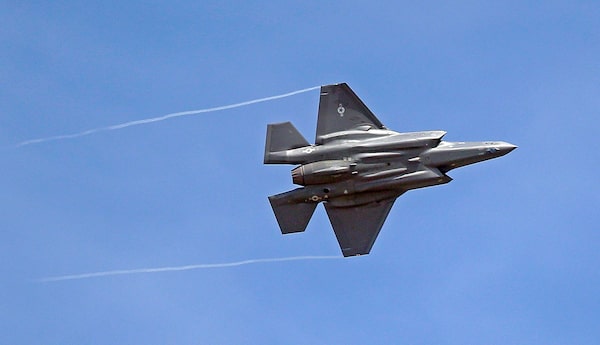
A Lockheed Martin F-35 jet flies over its new operational base at Hill Air Force Base, in northern Utah, U.S.Rick Bowmer/The Associated Press
Elinor Sloan, professor of international relations in the department of political science at Carleton University, is a fellow at the Canadian Global Affairs Institute.
For a bid to buy a plane designed to cut quickly through the skies, Ottawa’s pursuit of a future-generation fighter jet has been a long and torturous slog.
In 1997, Jean Chrétien’s Liberal government joined the F-35 Joint Strike Fighter program, a U.S.-led initiative conceived as a new way for allies to work together to design, develop and produce a fifth-generation fighter aircraft. In 2006, Ottawa signed a formal memorandum of understanding that gave Canada and the other eight partner nations the exclusive right to compete for contracts to produce such aircraft and, since 2007, Canadian companies have won more than US$1.3-billion in defence contracts related to the Joint Strike Fighter. With a production line that will be operating at full capacity starting this year, and is expected to produce about 10 times as many aircraft as exist today over the next few decades, this number promises to grow substantially.
Meanwhile, Canada’s nearly 40-year-old fleet of fighter jets – the CF-18s – continues to age. In 2010, the Harper government shelved its plan to sole-source buy the Joint Strike Fighter to replace them after a public outcry and a damning auditor-general’s report that found significant weaknesses in the process used by the Department of National Defence.
Then, when the Liberals took office in 2015 and promised an open and fair competition to replace the CF-18s, it also banned the F-35 from bidding – two contradictory positions. The Trudeau government quietly dropped that ban last year, and pre-qualified four companies to bid on a contract worth at least $15-billion: Sweden’s Saab Gripen, Britain’s Airbus Eurofighter, the U.S.'s Boeing F/A-18 Super Hornet and, yes, Lockheed Martin’s F-35 Joint Strike Fighter.
According to letters released last week, though, the U.S. government threatened to pull the Lockheed Martin F-35 from consideration last year over Ottawa’s insistence that Canada receive industrial benefits from the winning bid. In response, Ottawa relaxed its requirement on Thursday: Where bidders once had to commit to spend 100 per cent of the value of the aircraft’s acquisition and sustainment in Canada, bids will now only lose points in a three-category scoring system in the review process, instead.
With such exhausting twists and incompatible statements, it’s little surprise that it took three and a half years of the government’s four-year mandate just to get to the formal request-for-proposal stage.
But there is a way out of this morass: pursuing a back-to-basics focus on why we need this aircraft and what we need it to do.
To do so, we must focus on the proposed jets’ promised technical capabilities, which are paramount, and rightly weighted the highest of that three-category scoring system. The second category is cost, which of course is important to any government. The third is creating and sustaining a highly skilled work force within our own borders, a goal enshrined in Canada’s industrial trade benefits (ITB) policy, which requires a winning bid to guarantee it will make investments in Canada equal to the value of the contract. Each bid is scored by these three categories, weighed 60-20-20, respectively.
However, the Joint Strike Fighter program, which Canada has spent millions to join, does not fit neatly into the ITB policy. In those letters last year, the Pentagon and Lockheed Martin pointed out that Canada’s ITB terms are inconsistent with – and indeed prohibited by – the memorandum of understanding Canada signed in 2006, which says partners cannot impose industrial compensation measures. The solution reached on Thursday allows that memorandum to be obeyed, but since Canada will still give higher grades to bids that follow its ITB policy, questions remain as to whether the playing field has really been levelled.
All of this is important because of the growing competition between the major powers. Russian bombers and fighters, for example, are increasingly testing the boundaries of Canadian and U.S. airspace. More than ever, the focus needs to be interoperability with the United States, working together on NORAD and helping NATO allies in Europe. As a flying command-and-control platform, rather than a mere fighter, Canada’s next-generation jet must work with the United States’ most sophisticated systems, and include a seamless and secure communications capability – that is a critical and non-negotiable criterion. Indeed, as DND has said, the United States will need to certify the winning jet meets Washington’s security standards.
Some may question the federal government’s decision to relax the ITB rules, and to grant this certification sign-off. But whatever Canada buys must be able to address threats to us and to our allies until well into the 2060s. Our relationship with the United States, both in terms of geopolitics and military technology, is crucial. Despite our trade tiff, the United States remains our most important strategic partner. Canada can either take an active part in our own security, or leave it to the United States.